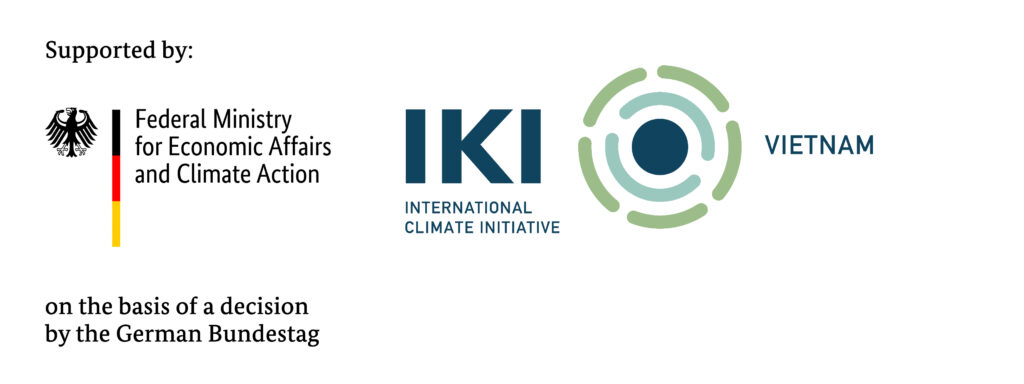Vietnam and especially the Mekong Delta is prone to extreme weather events and slow-onset disasters like sea level rise. The Government of Vietnam (GoV) has been collaborating with GIZ to conduct different climate risk assessments with the aim for better decision-making to ensure the resilience of existing and new infrastructures. The IKI Global Project “Enhancing Climate Services for Infrastructure Investments” (CSI) has been closely cooperating with national and international partners to assess the Mekong Delta’s largest sluice gate project, the Cai Lon – Cai Be system. With the overarching aim of sustainable development, this assessment looks at the comprehensive and systemic management of the planning stage of infrastructure investment projects. The climate-risk based recommendations have been implemented by the infrastructure project owner in adjusting the detailed design and construction of the sluice gate infrastructure accordingly in 2020-2021, before the completion and official launching of a resilient structure for Cai Lon – Cai Be in March 2022. The assessment is also in line with planning law, which specifies that all investments in the future need to consider climate risks.
The basis of the approach was the Engineering Protocol for Infrastructure Vulnerability Assessment and Adaptation to a Changing Climate (PIEVC) and its step-by-step methodology of climate risk assessment for infrastructure. The hazards considered included slow-onset events since they are of importance for infrastructure. Also, coincidences of climatic hazards with non-climatic hazards were analysed. It was analysed to detail which hazard will have which impact on different parts of the infrastructure. Based on the resulting potential impacts, engineering solutions were developed to mitigate those risks. The risk assessment approach combines qualitative and quantitative methods. In a mixed quantitative-qualitative assessment, individual risk severities and probabilities were classified from zero to seven (zero means no negative consequence and seven means failure of the infrastructure) for each infrastructure component and for the present and the future. Subsequently, the risk scores were categorised into low, medium, and high risks according to the PIEVC guidelines. High Risks require a considerable response in the detailed design phase, while a low risk level needs no immediate actions. Results were visualised in a combined risk matrix for current and future conditions, climate and non-climate hazards.
The climate risk assessment approach has been substantially adapted to the local conditions of the Mekong Delta, giving rise to comprehensive recommendations on technical design and operation of the Cai Lon – Cai Be water infrastructure, as well as estimation of cost-benefit for the climate-proofing measures. The infrastructure project owner adjusted the detailed design and TORs with relevant construction contractors. Among the uptaken recommendations, there were adjustments on:
1) Upgrading concrete for pillars and ship locks to limit cement corrosion in high salinity, high humidity and variable temperature conditions;
2) Epoxy coating for sluice gates to prevent corrosion;
3) Moving the ship lock from middle of the river to the shore and making underground electric transmission lines to prevent the possibility of failures and interruption in stormy and extreme weather conditions (Figure 1).
Furthermore, practice of portfolio scan risk assessment for 84 coastal sluice gates in the Kien Giang province has also shown its advantage in supporting decision makers identify high risk infrastructures, thereby making decisions on prioritizing projects or requiring further climate risk assessment steps for important and highly vulnerable projects under the impacts of climate change. The study results proved that the PIEVC Protocol has a high potential to be applied for climate risk assessments of infrastructure (both planned projects and existing infrastructure) in Viet Nam. These climate-informed decisions helped to make the infrastructure and the entire delta area under the water regulation of this infrastructure more resilient to changing climate conditions.
In Viet Nam’s current context, where the effects of climate change are threatening the infrastructure with further negative impacts on social, economic and environmental conditions, climate smart decisions must be made today and climate finance mechanisms such as adaptation funds, green budgets, risk transfer, etc. should be well prepared and accessible. Best practices on climate risk assessment, with tools ready to be applied or further customized, offer the opportunity to realize a higher climate resilience in the near future.

Figure 1: Climate proofing measures applied during the construction of Cai Lon – Cai Be Sluice Gates

Figure 2: The Launching of Cai Lon – Cai Be Sluice Gates in March 2022 in Mekong Delta. Photo source: Hydraulic Project Investment and Construction Management Board No.10 (PMU 10)
Source: GIZ – CSI project in Vietnam
Contact
(Dr.) Nguyen Thi Minh Ngoc, Senior Technical Advisor, GIZ Vietnam
Global Project “Enhancing climate services for infrastructure investments” (CSI)
For further information please visit:
» CSI Website
